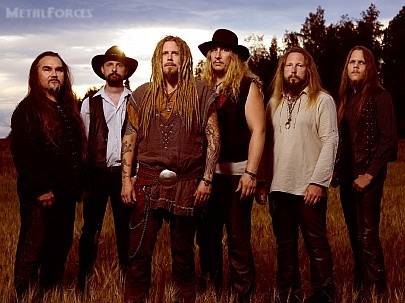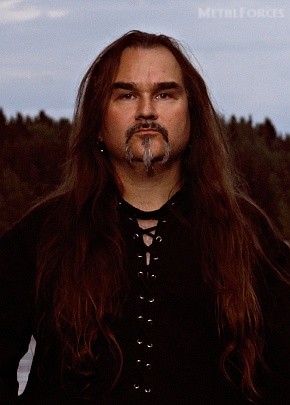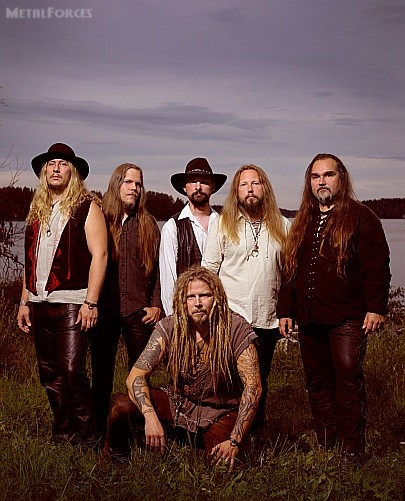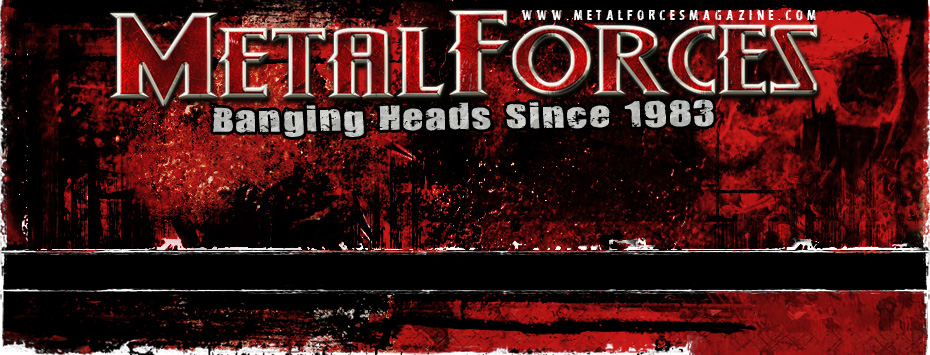
KORPIKLAANI – Folk Metal’s ‘Iron Fist’
Anthony Morgan
February 2011

|
While the English language is arguably king undisputed, this isn’t to say that all metal outfits have wholly forsaken their native tongues. Though some like Italy’s Lacuna Coil or Germany’s Accept favour English penned lyrics, to name two of very, very many, others like Deutsch industrial metallers Rammstein embrace their primary language almost wholeheartedly, or at least partially (as is the case with Norway’s Dimmu Borgir). A folk metal oriented sextet of Lahti, Finland origin, Korpiklaani intense affection for Finnish ambience is still evident upon seventh full-length affair Ukon Wacka.
“First of all, the songs on the album are a bit different than the last few albums,” explains bassist Jarkko Aaltonen. “This time, all of the songs were actually written by Jonne Järvelä. Previously, the violin player has written some songs, the accordion player has written some songs and I have written some songs, but this time everybody else was basically being just too fucking lazy to do anything. Nobody could really come up with anything, so it’s all Jonne. I think we started to demo and rehearse songs about a year ago. We wrote pretty much the same as usual in that we weren’t really sure how the album would end up, but then when we had rehearsed them for awhile we realised that it would be a rock’n’roll album. All our albums have been in either two or three languages.
“The previous record label that we were on actually complained that we had been writing too much lyrics in Finnish, and they demanded a certain amount of English language tracks on the albums. At that time, when we had an instrumental track on the album we always named them in English, and the record label would think that they were all English lyrics (laughs). This time though, at one point we realized that all the songs on the album were going to be in Finnish, and we thought that it might be a problem with the record label. We contacted them and said that it’s likely that the whole album would be in Finnish, but Nuclear Blast was quite happy, saying ‘It doesn’t matter – go and make an album.’”
The fact that Nuclear Blast elected to give Korpiklaani such creative freedom is a positive sign. “Yeah, exactly,” Jarkko agrees. “I don’t know what other option we had, except writing new songs. When we were just about to start recording the album, we honestly didn’t even pay attention to that. When we were doing the recordings, we realised ‘Oh fuck – they’re all in Finnish.’”
An abundant wealth of Finnish metal acts – whether they be Stratovarius, Nightwish or Children Of Bodom to name some of the country’s more famous exports – opt to learn the English language and pen English lyrics. Why is it that Korpiklaani tend to write Finnish language lyrics Jarkko? “First of all, we don’t really decide ‘Now we’re gonna write in Finnish.’ All the time, we’re developing and changing the notes which end up in the song, and in the end, we know what language the song is going to be in. The origins of the band are in a group called Shaman, and Jonne was actually singing in the Sámi language in that band, the language of the Sámi people in Lapland (Sápmi). From then on, I think Jonne wanted to sing in Finnish, but he wasn’t so happy with the way his Finnish lyrics came out. Everything sounded shit to him, so he started writing in English because – especially when English isn’t your first language – you can say things that sound cool, that sound good, even when the same sentence would mean total nonsense in Finnish or any other language.
“Like ‘Be-bop-a-lula / She’s my baby’; that’s a rock classic, but says nothing. Later though, we started to have some outside help from a friend of ours (Virva Holtiton) – he started to write us some lyrics in the traditional, Finnish Kalevala style. we started to use them on our third or fourth album, and at that time, it was divided; the guest lyrics were all in Finnish, and what we wrote ourselves was basically in English. That’s why our albums were divided into two different languages, but then later, it just so happened that Jonne started to also write in Finnish because he realised that it’s not that difficult. Basically, all of the songs for Ukon Wacka were written in Finnish. It doesn’t mean that that will be the case for the next album, but at the moment, our lyrics are written in Finnish.”
Ukon Wacka’s title cut features guest vocals from Tuomari Nurmio, a famous rock artist in Finland whose album catalogue dates back 30-plus years. “Jonne did the demo at home, and then when we were rehearsing the song we made fun of him, saying ‘We didn’t know that you sound exactly like Tuomari Nurmio’,” the bassist reveals. “He did, especially from when Tuomari Nurmio was younger and had a different style about 30 years ago. We were making fun of that, but then we started to think it would be cool to have Tuomari on the album. Then we realised that our live sound guy actually handled the recording for Tuomari Nurmio’s live DVD, so he was of course in contact with Tuomari Nurmio. We just told him ‘Why don’t you ask Tuomari Nurmio if he’s interested?’ He was, and we got his contact information. We sent Tuomari Nurmio the demo, and he liked the song. He wanted to have all of the old Korpiklaani albums because he wanted to get in the mood of what we wanted to do – he was into that quite a lot, actually. It started from a stupid joke in the rehearsal room, but then it ended up that the track had excellent vocals from him.”

|
‘Päät Pois Tai Hirteen’, meanwhile, is a tribute to veteran Finnish hard rock outfit Peer Günt. “When Peer Günt brought their first and second album out, they were an excellent hard rock band, a trio in the classic Motörhead style,” Jarkko exclaims. “Honestly, I was never personally that much into them but could really especially appreciate their live shows. They were a really good rock’n’roll band, but for Jonne the feeling was different because I think they played his first ever live show, and he has been hooked ever since – that was why we recorded this song. Jonne was listening to the radio and this song was on the radio, and he just started to sing mock lyrics on top of it in Finnish, realising ‘Hey, wait a minute. I’m gonna make a demo of this.’ We then got the demo, and the rest of us said ‘Are you being serious?’ ‘Yeah.’ ‘Oh, ok.’”
Lead cut ‘Tequila’ exhibits a Mexican flavour, an ode to Korpiklaani’s South American audience. “We did a short tour of South America in March 2010 – only eight to nine shows, but we spent almost three weeks there because we were all travelling and so on,” the musician remembers. “We had an excellent time there. It wasn’t all fun there though definitely, because there were whatever problems you can end up with when you have to go to new places and you have to work with new promoters. There were some fistfights almost, which was the downside. Also, there was an earthquake and some cancelled shows because the venues had collapsed, and all the police came to stop one of our shows after five to six songs – that kind of stuff. Otherwise, out of those nine shows, eight were brilliant. We had really, really lovely audiences everywhere we went, and we met a lot of Mexican people, drinking a lot of alcohol with them and even without them. It was a magnificent trip.”
Directed by Markku Kirves, a music video was filmed for the song. “Actually, I can honestly say that I hate doing videos; I don’t want to be at the video shoots, and I don’t want to know about the videos,” the bassist confesses. “I only do what is needed, so I can’t really speak to you about how it happened in the first place or whatever. The video was filmed in this small forest next to a farm in the middle of fucking nowhere though – it was so freezing. We were standing there, and because we needed the darkness we didn’t do anything during the day. We arrived there in the afternoon and got dressed into whatever we wore for the video, and set up the stuff in the forest. Then of course when the night came, it started to get colder and colder. It was so fucking freezing, and you couldn’t even do anything. You had to stand where you were supposed to stand. They used light to brighten the forest, so when they were filming someone else we went next to the lamp because that was the only warm thing there, and then they tell you ‘Get off the light’, ‘Don’t block the light’ or whatever. We ended up standing there I don’t know how many hours freezing our arses off.”
Ukon Wacka exploits instruments uncommon in the metal genre, though perhaps more common in metal full-lengths with folk traits. “There’s instruments that we’ve always had, like the violin and the accordion,” Jarkko muses. “Some of the other instruments we’ve had before as well, but maybe not so much. We had the mandolin, baritone mandolin, and so on. Not so unusual for metal in general but for us, for the first time we were actually using seven-string guitars and baritone guitars, so there’s some low-end parts on the album as well. Other than that though, I don’t think there’s that much which is different.”
Meshing together instruments like the violin and the accordion with guitars, bass and drums theoretically presents issues during the mixing process, something the Korpiklaani member concedes. “That is always a problem because there is quite a lot of stuff that you have to make audible, especially with the last two albums. We have a producer now who is really into encouraging us to go deeper. On the last two albums, there is a better sound in my opinion, the way certain instruments stay away from other instruments. We had this small discomfort because we were on tour, and we had to leave the mixer / producer by himself. He kept sending us files, and we downloaded them whenever we found a network that worked – we listened to them on the bus and kept sending feedback. ‘No, that is too high in the mix’, ‘This is too low’, and stuff like that. It is a constant fight for space, I’d say. The live situation is different, but the same rules still apply.”
“I’d say that this is a rock’n’roll album, because I like the fact that it kicks off with a really good rocking number, and it doesn’t stop from there” the bassist says of the group’s 2011 outing. “This is a quote from Lemmy Kilmister: ‘I think we’re a rock’n’roll band.’”

|
Speaking of things Motörhead related, Ukon Wacka’s bonus number is an interpretation of ‘Iron Fist’, the title composition from Motörhead’s fifth studio record. “At one time, we had only done two to three shows in the UK, maybe a couple of shows in London,” discloses the musician. “Then we were heading there for our first UK tour which had about seven shows, and we thought ‘Ok, this is the rock’n’roll capital of Europe at least, if not the world.’ We had to do something different, so we thought ‘Ok, let’s do something different.’ It was Matti’s idea to do Motörhead live. We rehearsed ‘Iron Fist’ for that tour, and we played that every night in the UK, which is quite fitting since both Jonne and myself are huge Motörhead fans and have been since the early 80s. Motörhead is the most important band and person that has ever been in rock. Once we were already done with this album, we were told by the record label that we needed a bonus track for the digipack and Japanese releases and whatever. We said ‘But we aren’t in the studio – we’re on tour.’ We realised though that we had four studio days left from our contract with the studio, so we could still record something. We wondered ‘What do we record? What do we know? What don’t we have to rehearse?’ I said ‘Let’s record ‘Iron Fist’’, and that’s what we did. Actually, for those days that we were recording, our accordion player couldn’t get into the studio because he was in Germany at his girlfriend’s. We ended up recording the accordion part in my living room – I don’t have a recording studio as such, but I do have recording equipment. That’s why we recorded ‘Iron Fist’; as a tribute to the best rock’n’roll band ever.”
So the band’s ‘Iron Fist’ cover definitely has that Korpiklaani flavour? “It has an excellent violin solo (laughs).”
Since April 2006’s Tales Along This Road, the folk metal outfit’s third studio proper, a bearded gentleman has appeared on all Korpiklaani artwork. “We call him ‘Vaari’, which is basically ‘Grandpa’ in Finnish,” discloses Jarkko. “There’s not really much to that story. For the first couple of albums and also on the Shaman album, we used this old shaman logo which we still use on some occasions. We just found this logo on a 1,000s of years old wall carving for example, which is just a symbol of who we are – we’ll use the original carvings. A few years ago, I think Jonne got the idea that we cannot go on with that forever, and he had the idea that we should use a live symbol. He just gave the idea to the cover artist – Jan Yrlund – who came up with this old chap who has been serving us quite well for five albums.”
Between 2003 and 2011, Korpiklaani have issued a grand total of seven studio albums, a figure prolific by modern standards. “We don’t really think about that that much,” the bass player notes. “We record and release albums when we have enough songs to make an album, and so far it’s been quite often, regular, although this last album took longer to write and record. That’s perhaps because we’ve been touring more and playing more shows away from home, and the fact that only Jonne wrote songs for this album because the rest of us had some other things to do. When we were growing up and buying music by the bands that we love – Motörhead or Iron Maiden or whoever – at that time, and especially before that in the 70s and 60s, bands released an album every year. It was a normal thing to do; Iron Maiden released their first six albums in six years, and bands like Thin Lizzy sometimes released two albums within the space of a year. Creedence Clearwater Revival released seven albums in four years or something like that. It was normal at the time. I think we are just still doing what we think bands are supposed to do because we grew up with bands like that.”
Ukon Wacka was released on February 4th, 2011 in Europe and on the 15th in North America, all through Nuclear Blast Records.
Interview published in February 2011. All photographs by Harri Hinkka.





